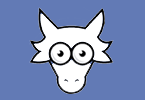Young readers want to be scared, but parents don’t want to be alarmed. Alex Woolf – veteran young adult (YA) horror author of titles such as Soul Shadows, which was shortlisted for the RED Book Award, and Aldo Moon and the Ghost at Gravewood Hall – looks at how to write horror fiction aimed at young people on the cusp of maturity.
We’re exposed to horror stories from an early age: a ravenous wolf dressed as a grandmother, a witch that fattens up a little boy in a cage, a gorgon with a face that is literally petrifying. Children have always loved being unsettled, scared, shocked and terrified, but there are, of course, limits. All who write horror for the young must be aware of these and tread sensitively.
Achieving this balancing act can be particularly tricky, since young adults aren’t going to be satisfied with the genteel fantasy horror of goblins and monsters under the bed. On the other hand, anything too brutal or gory may not be appropriate either – at least in the eyes of their teachers, librarians and parents. Besides scariness, there are several other aspects of YA horror that have to be pitched right if it’s going to succeed in a crowded market. Here are a few tips for making yours reach out and grab the right readers.
Give Your Topic a Twist
Young adults may no longer be captivated by the simple fairy tales of early childhood, but that doesn’t mean they won’t enjoy stories featuring similar supernatural beings. Ghosts, witches, vampires, zombies and werewolves have all been repurposed successfully in YA horror – the trick to find a new and exciting twist.
One way might be to make the monsters teenagers themselves, with all the usual human problems like dating and acne being complicated by a thirst for human blood or a tendency to turn hairy and howl at the moon. If this is your preferred route, remember not to rely too much on laughs. Horror stories must, first and foremost, be scary. When choosing a topic, try casting your mind back to when you were a teenager and ask yourself, “Would this have scared me then?”
Go Easy on the Gothic
Setting is one of the aspects that really marks out YA horror from spooky stories aimed at middle grade or younger audiences. Gone are the eerie forests and gothic castles of fairy tales, and along with them the comforting sense that this is a fantasy world with bad things that can’t really happen to us. YA horror is often set disconcertingly close to home, and usually in modern times.
Common settings include schools, friends’ houses, pizza joints, shopping malls, bowling alleys, and other teen hangouts. That doesn’t mean protagonists enjoy much personal autonomy. The Dead House (Dawn Kurtagich) is partially set in a hospital for the mentally ill, where freedoms are severely curtailed. In Michael Grant’s Gone series, an invisible barrier cuts a town off from the outside world.
There are no absolute rules, though. Many great modern YA horror tales have a distinctly old world or otherworldly backdrop. The Forest of Hands and Teeth (Carrie Ryan) and Miss Peregrine’s Home for Peculiar Children (Ransom Riggs) are just two examples of YA horror novels with fantastical settings.
Empower Your Protagonists
The typical protagonist of a YA horror novel is a teenager with a troubled past, absent or dysfunctional parents, and/or an almost insane willingness to venture towards a suspicious noise in the middle of the night armed with nothing but a torch. The most important thing to remember about YA horror is that teen characters have agency. They are the powerful, brave and clever ones in the story.
Unlike in horror stories geared toward younger audiences, where parents are needed for money and car rides and to tell the kids to stop imagining things, YA horror parents are weirdly absent, and the role of adult characters is usually either to terrorize our intrepid young heroes and heroines, or to offer them assistance (unless they are the police, in which case they are almost invariably useless).
Don’t Hold Back on the Evil
Every successful YA horror tale requires an evil, yet also mysterious and fascinating villain at its heart. He, she or it can be either human or supernatural, but this assignation often marks it out from middle grade horror, where the villains tend to be magical entities. One popular subgenre of YA horror featuring human villains is the slasher, such as There’s Someone Inside Your House (Stephanie Perkins) or I Know What You Did Last Summer (Lois Duncan), where the killer is usually a mentally disturbed person stalking and killing young people because of some perceived wrong. These tend to be fairly formulaic and predictable, yet undeniably successful.
Modern YA horror features an imaginative array of supernatural villains, too, from the vengeful and gluttonous spectres of A Banquet for Hungry Ghosts (Ying Chang Compestine) to the reverse-aged Hollowgasts of Miss Peregrine’s Home for Peculiar Children. But if you don’t feel up to creating your own evil entity, there are plenty of traditional monsters from which you can take your pick.
Of these, the undisputed titan of YA horror villains remains the vampire. The trouble is there’s such a glut of these books on the market today. You’ll need to work extra hard to make your undead antagonist stand out. You might wish to take inspiration from The Coldest Girl in Coldtown (Holly Black), which introduces the debonair bloodsucker Lucien Moreau with his trademark cream suit and white shirt (the better to show off the blood of his victims), or the mysterious Mr. Crepsley and his performing spider in Darren Shan’s Cirque du Freak. And of course, one cannot ignore the beautiful sparkling vampires in Stephanie Meyer’s classic Twilight series.
Keep It Tight and Punchy
In the age of Instagram and Snapchat, the typical teen reader’s attention span is pretty short, so it’s best to structure your horror novel in tightly written, punchy action scenes with plenty of scares. These can be interspersed with quieter moments to explore character, establish mood, and build suspense.
It’s almost obligatory these days to open your novel in a moment of high-octane excitement to grab the reader’s attention and lure them in. Personally, I think this can be overdone, and I think a novel with a slow, yet intriguing or unsettling opening can be just as effective. Remember also to use plenty of sudden plot twists – teens love to be kept guessing about certain aspects of the story, such as who the next victim will be, and who is really the villain.
Build Suspense
In terms of suspense, the same rules apply with YA as with all horror writing, only more so. So while an adult horror writer might be content to build suspense slowly with subtle hints of menace, the YA author likes to set the pulse racing early and keep that momentum going.
The easiest way to do this is to get inside the lead character’s head so the reader gets to share their apprehension about what might be lurking in the cellar, or what could emerge when the sun goes down. This is why a lot of YA horror is written in the first person present, creating a strong sense of immediacy, so that whatever is happening is happening right now.
Another fun way of building a menacing atmosphere is through imagery: a raven picking at the entrails of a rat, a fat centipede crawling out of a doll’s eye socket, a shadowy figure at the window of an abandoned house. YA readers adore this kind of thing.
Be Scary
How scary, exactly, are you allowed to be? The surprising and gratifying truth is that with YA horror, there are no set-in-stone limits. Be as scary as you can – you can always backtrack later if you feel you’ve overdone it. Fear is subjective and difficult to quantify. I’ve never found snakes scary, for example, but have a particular dread of scuttling creatures like spiders and beetles. And, as every horror writer ought to know, the fear comes from what you don’t mention, the things you hint at but are never seen or entirely understood.
Nothing fully described, however horrid, can ever be as scary as things imagined, and the teenage imagination is a wondrous and powerful thing. Readers will readily form their own mental images of the monstrous entities and dark deeds that haunt your book. What you should be very wary of in YA horror is focusing on gore, or describing violence in gruesome detail.
Some YA authors manage to pull this off, such as Rick Yancey in Monstrumologist. He writes his gory scenes with an almost cartoonish exuberance, with heads wrenched from necks and steaming geysers of blood. This takes quite a bit of skill, but can be fun if done well. On the other hand, a decent horror writer should be able to evoke plenty of terror without indulging in an all-out splatterfest.
Beware Happy Endings
Unlike younger readers, the YA audience does not hanker for a happy ending. In fact, they might be seriously disappointed by a conclusion where all the plot threads are neatly tied up, the villain vanquished, and the good guys riding off into the sunset.
Rather, they want to be left feeling unsettled and discombobulated, with everything they thought they knew thrown out the window. They want to know that the horror, though foiled for now, may come back, that the evil has spread, and that new unsuspecting victims are about to get the shock of their lives.
Above all, YA horror fans love a sequel!




